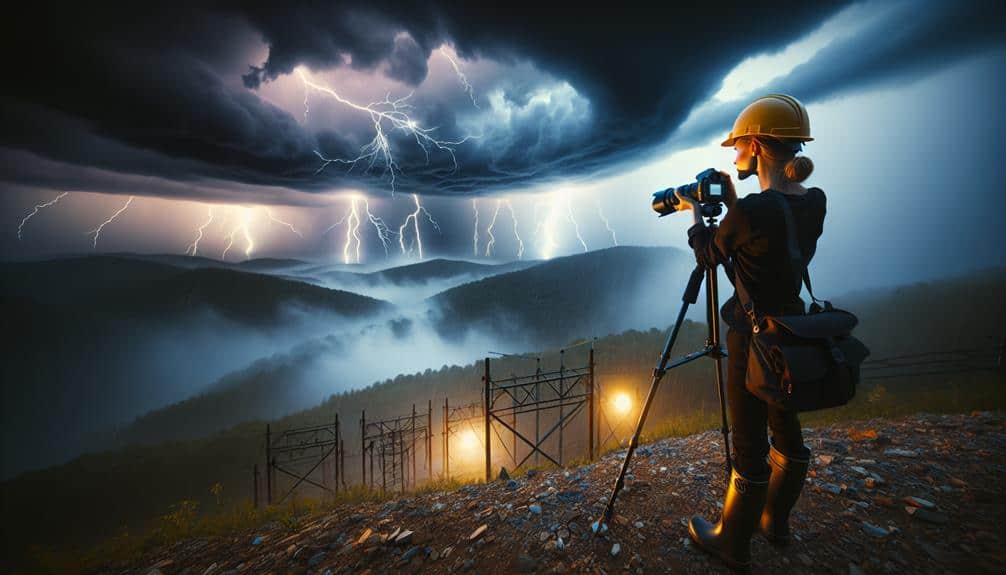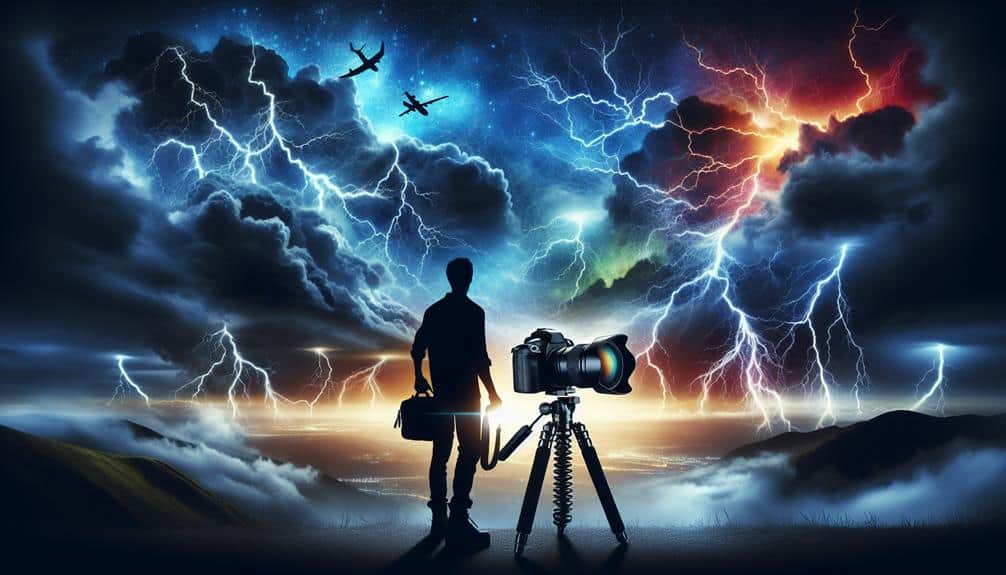We'll need a high-speed camera, sturdy tripod, and lightning trigger for capturing lightning strikes. We should set our cameras to manual mode, with a low ISO and wide aperture, to optimize image quality. Choosing open, elevated areas with minimal light pollution and using real-time weather tracking enhances our positioning. Timing shots by tracking storm patterns and employing long exposure techniques is key. Safety remains paramount; position remotely, perform risk assessments, and have an emergency response plan. Post-processing using advanced software and data-driven adjustments can perfect our images. Stay with us to grasp a deeper understanding of these techniques.
Key Points
- Use a sturdy tripod and a remote shutter release to prevent camera shake.
- Set your camera to manual mode with a low ISO and long exposure time.
- Choose open areas with unobstructed views and minimal light pollution.
- Track storm patterns and real-time weather to anticipate lightning strikes.
Equipment You Need
To effectively record lightning strikes, we need a high-speed camera, a lightning detector, and a GPS system for accurate data collection. Our high-speed camera must be paired with necessary camera accessories like a remote shutter release and extra batteries to guarantee continuous operation during a storm. These accessories allow us to capture every fleeting moment without interruption.
Tripod stability is vital. A sturdy tripod will keep our camera steady, even in adverse weather conditions. Lightweight tripods may falter under strong winds, so opting for a heavy-duty model ensures our setup remains secure.
Lighting conditions are unpredictable during storms, requiring us to be prepared for sudden changes. A lightning detector helps us anticipate strikes, allowing us to adjust our positioning and camera settings promptly. This device significantly improves our chances of capturing high-quality footage.
Lastly, a GPS system is essential for precise data collection. By logging the exact coordinates of each strike, we can analyze patterns and correlations with specific weather conditions. This data-driven approach not only enriches our understanding but also empowers us to share accurate information with the scientific community.
Together, this equipment empowers us to capture and analyze lightning strikes with precision and freedom.
Ideal Camera Settings
Determining the ideal camera settings is necessary for capturing the fleeting and dynamic nature of lightning strikes with clarity and precision. To start, we should set our exposure settings with a long shutter speed, typically between 10 to 30 seconds. This allows the camera to capture multiple lightning strikes within a single frame, enhancing the overall composition.
A narrow aperture, around f/8 to f/16, guarantees a deep depth of field, keeping both foreground and background in sharp focus. For ISO, we should aim for a lower value, such as ISO 100 or 200, to minimize noise. Given the unpredictability of weather conditions, focusing techniques are critical.
Manually set the focus to infinity while making sure the lens is switched to manual focus mode to avoid hunting during the exposure. Additionally, using a sturdy tripod is non-negotiable to maintain stability during long exposures. A remote shutter release or intervalometer can further prevent camera shake, allowing us to capture crisp and detailed lightning strikes.
Monitoring weather conditions in real-time is essential; adjusting settings on the fly can compensate for changing light conditions, ensuring each shot is as impactful as the storm itself.
Choosing the Right Location
Selecting an ideal location for recording lightning strikes involves analyzing geographical features, weather patterns, and safety considerations. We need to prioritize open areas with a wide, unobstructed view of the sky. Elevated terrains, such as hills or ridges, provide optimal visibility and enhance our chances of capturing the full extent of lightning activity. Analyzing topographical maps and meteorological data allows us to identify regions with high lightning frequency.
Weather conditions are paramount. We should focus on areas prone to thunderstorms, particularly during peak lightning seasons. Real-time weather radar and satellite imagery help us track storm cells and predict lightning-prone zones. For instance, regions within the Intertropical Convergence Zone (ITCZ) or known lightning hotspots like Florida or Central Africa are ideal.
Lighting conditions are equally essential. We must avoid urban areas with excessive light pollution, as it can diminish the clarity and contrast of our recordings. Dark skies, typically found in rural or remote locations, offer superior conditions for capturing vivid lightning strikes. Additionally, ensuring minimal ambient light increases the dynamic range of our images.
Safety is non-negotiable. While the thrill of capturing lightning is exhilarating, we must remain at a safe distance from storm activity and have a clear, accessible escape route.
Timing Your Shots
Once we've identified the ideal location, synchronizing our efforts with the peak moments of lightning activity becomes essential for successful recordings. Understanding weather conditions is vital; tracking storm patterns using radar and weather apps allows us to predict when and where lightning is most likely to occur. Analyzing meteorological data, such as cloud formations and atmospheric pressure, enhances our ability to anticipate strikes accurately.
Timing is everything. We should employ long exposure techniques to maximize our chance of capturing a strike. By setting the camera to a low ISO and using a small aperture, we can leave the shutter open for extended periods. This technique increases our likelihood of recording multiple strikes in one shot, adding dynamism to our composition.
Additionally, effective composition techniques require us to frame our shots meticulously. Including foreground elements, like trees or buildings, can provide scale and context, transforming a simple lightning shot into a compelling narrative. We must also remain flexible; lightning is unpredictable, so adjusting our composition on the fly is sometimes necessary.
Safety Precautions

Ensuring our safety while recording lightning strikes requires a thorough understanding of the inherent risks and adherence to strict safety protocols. Conducting a detailed risk assessment is paramount. We need to identify potential hazards such as proximity to water bodies, tall structures, or metal objects that can attract lightning. By analyzing weather data, we can predict the likelihood of lightning activity and plan our recording sessions accordingly.
We should always prioritize an effective emergency response plan. This includes having a designated safe area, often a fully enclosed, grounded structure, that we can retreat to rapidly if the storm intensifies. Every team member must be familiar with this plan and equipped with communication devices to stay in constant contact.
Positioning ourselves at a safe distance from the storm, ideally more than 10 kilometers away, minimizes the risk of direct strikes. Using remote-triggered cameras and lightning sensors can further distance us from danger while capturing high-quality data. Wearing rubber-soled shoes and avoiding contact with conductive materials enhances our personal safety.
Post-Processing Tips
Post-processing our captured lightning strike data requires meticulous attention to detail and the use of advanced image enhancement software. First, we should focus on editing techniques that enhance the colors and contrast of the lightning strike. Lightning often appears in a range of hues, from white to blue to purple, and we need to emphasize these natural variations to make our images more impressive and visually enthralling.
For software recommendations, Adobe Photoshop and Lightroom are industry standards for photo manipulation and offer extensive tools for color correction, contrast adjustment, and noise reduction. These programs allow us to fine-tune the image precisely, ensuring that every bolt of lightning is clear and vivid.
We should also consider using specialized software like Aurora HDR for high dynamic range processing. This can help in merging multiple exposures to create a single image with balanced lighting, essential for capturing the intensity and brilliance of lightning strikes.
Data-driven adjustments, such as histograms and exposure levels, make our post-processing more precise. By understanding the exact light values in our images, we can make informed decisions, enhancing the overall quality.
Let's embrace these editing techniques and software tools to elevate our lightning photography to professional standards.
Frequently Asked Questions
How Can I Predict When and Where Lightning Will Strike?
We can predict lightning strikes by utilizing advanced lightning prediction tools and storm tracking systems. These technologies enhance location accuracy, allowing us to take necessary safety precautions while maintaining our freedom to observe nature's power safely.
What Are Some Common Mistakes to Avoid When Recording Lightning?
We often forget proper camera settings and positioning, compromising our shots. Common mistakes include neglecting safety precautions and equipment protection. To maximize freedom, prioritize safety and make sure your gear is shielded from the elements.
Can I Record Lightning Strikes Using a Smartphone Camera?
Yes, we can record lightning strikes using a smartphone camera. Adjust camera settings for long exposure, guarantee stable positioning, and acknowledge smartphone limitations in capturing high-speed events accurately. However, our freedom to experiment remains boundless.
How Do I Protect My Equipment During a Lightning Storm?
Remember the time we shielded our gear with plastic covers? It's essential for equipment protection. Use a tripod for stability and adjust camera settings remotely. Always prioritize safety measures by staying indoors during lightning photography.
Are There Specific Weather Conditions That Increase the Likelihood of Capturing Lightning?
For lightning photography, we should monitor data on atmospheric instability and moisture, which enhance lightning activity. Effective storm chasing strategies involve tracking supercells and squall lines, maximizing our chances of capturing electrifying moments safely and efficiently.


